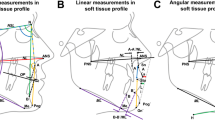Abstract
Conventional protocol for orthodontic treatment followed by orthognathic surgery for skeletal discrepancies is not readily justified, since both procedures cause significant reduction of the overall masticatory function. In order to facilitate the procedure, a pre-orthodontic orthognathic surgery (POGS) has been suggested and practiced. One of the essential factors may be the predictability of postsurgical tooth movement. The miniscrew-type TADs enable not only individual tooth movement but also the movement of segment and total arch. Underlying biomechanical advantages of segmental movement also supports the new protocol. In case of narrow maxillary arch, a miniscrew-assisted rapid palatal expander can be effective for the preliminary transverse correction prior to surgery, which also contributes to the establishment of stable occlusion in short period of time. Therefore, the TADs are regarded indispensible for the POGS procedure.
Access this chapter
Tax calculation will be finalised at checkout
Purchases are for personal use only
Similar content being viewed by others
References
Jacobs JD, Sinclair PM. Principles of orthodontic mechanics in orthognathic surgery cases. Am J Orthod. 1983;84(5):399–407.
Thomas GP, et al. The effects of orthodontic treatment on isometric bite forces and mandibular motion in patients before orthognathic surgery. J Oral Maxillofac Surg. 1995;53:673–8.
Katsumata A, et al. 3D CT evaluation of masseter muscle morphology after setback osteotomy for mandibular prognathism. Oral Surg Oral Med Oral Pathol Oral Radiol Endod. 2004;98(4):461–70.
Trawitzki LVV, et al. Masseter muscle thickness three years after surgical correction of Class III dentofacial deformity. Arch Oral Biol. 2011;56:799–803.
Nicolet C, et al. Lip competence in Class III patients undergoing orthognathic surgery: an electromyographic study. J Oral Maxillofac Surg. 2012;70:e331–6.
Nagasaka H, et al. “Surgery first” skeletal Class III correction using the skeletal anchorage system. J Clin Orthod. 2009;43(2):97–105.
Epker BN, Fish L. Surgical-orthodontic correction of open-bite deformity. Am J Orthod. 1977;71(3):278–99.
Lee RT. The benefits of post-surgical orthodontic treatment. Br J Orthod. 1994;21:265–74.
Watted N, Witt E, Bill JS. A therapeutic concept for the combined orthodontic surgical correction of angle Class II deformities with short-face syndrome: surgical lengthening of the lower face. Clin Orthod Res. 2000;3:78–93.
Liou EJ, et al. Surgery-first accelerated orthognathic surgery: orthodontic guidelines and setup for model surgery. J Oral Maxillofac Surg. 2011;69(3):771–80.
Liou EJ, et al. Surgery-first accelerated orthognathic surgery: postoperative rapid orthodontic tooth movement. J Oral Maxillofac Surg. 2011;69(3):781–5.
Mueller M, et al. A systematic acceleratory phenomenon (SAP) accompanies the regional acceleratory phenomenon (RAP) during healing of a bone defect in the rat. J Bone Miner Res. 1991;6(4):401–10.
Kitahara T, et al. Hard and soft tissue stability of orthognathic surgery. Angle Ortho. 2009;79:158–65.
Joss CU, Vassalli IM. Stability after bilateral sagittal split osteotomy setback surgery with rigid internal fixation: a systematic review. J Oral Maxillofac Surg. 2008;66:1634–43.
Ueki K, et al. The effects of changing position and angle of the proximal segment after intraoral vertical ramus osteotomy. Int J Oral Maxillofac Surg. 2009;38:1041–7.
Navarro R d L, et al. Histologic and tomographic analyses of the temporomandibular joint after mandibular advancement surgery: study in minipigs. Oral Surg Oral Med Oral Pathol Oral Radiol Endod. 2009;107:477–84.
Jung HD, Jung YS, Park HS. The chronologic prevalence of temporomandibular joint disorders associated with bilateral vertical ramus osteotomy. J Oral Maxillofac Surg. 2009;67:709–803.
Brunelle JA, Bhat M, Lipton JA. Prevalence and distribution of selected occlusal characteristics in the US population, 1988–1991. J Dent Res. 1996;75(Spec No):706–13.
Betts NJ, et al. Diagnosis and treatment of transverse maxillary deficiency. Int J Adult Orthodon Orthognath Surg. 1995;10(2):75–96.
Altug Atac AT, Karasu HA, Aytac D. Surgically assisted rapid maxillary expansion compared with orthopedic rapid maxillary expansion. Angle Orthod. 2006;76(3):353–9.
Alpern MC, Yurosko JJ. Rapid palatal expansion in adults with and without surgery. Angle Orthod. 1987;57(3):245–63.
Lee KJ, et al. Displacement pattern of the maxillary arch depending on miniscrew position in sliding mechanics. Am J Orthod Dentofacial Orthop. 2011;140(2):224–32.
Park HS, Lee SK, Kwon OW. Group distal movement of teeth using microscrew implant anchorage. Angle Orthod. 2005;75(4):602–9.
Choy K, et al. Effect of root and bone morphology on the stress distribution in the periodontal ligament. Am J Orthod Dentofacial Orthop. 2000;117:98–105.
Yamada K, et al. Distal movement of maxillary molars using miniscrew anchorage in the buccal interradicular region. Angle Orthod. 2009;79:78–84.
Bechtold TE, et al. Distalization pattern of the maxillary arch depending on the number of orthodontic miniscrews. Angle Orthod. 2013;83:266–73.
Lee KJ, et al. Computed tomographic analysis of tooth-bearing alveolar bone for orthodontic miniscrew placement. Am J Orthod Dentofacial Orthop. 2009;135(4):486–94.
Uysal T, et al. Dental and alveolar arch widths in normal occlusion, Class II division 1 and Class II division 2. Angle Orthod. 2005;75:941–7.
Melsen B. Palatal growth studied on human autopsy material. A histologic microradiographic study. Am J Orthod. 1975;68(1):42–54.
Koudstaal MJ, et al. Surgically assisted rapid maxillary expansion (SARME): a review of the literature. Int J Oral Maxillofac Surg. 2005;34(7):709–14.
Bailey LJ, et al. Segmental LeFort I osteotomy for management of transverse maxillary deficiency. J Oral Maxillofac Surg. 1997;55(7):728–31.
Phillips C, et al. Stability of surgical maxillary expansion. Int J Adult Orthodon Orthognath Surg. 1992;7(3):139–46.
Lee KJ, et al. Miniscrew-assisted nonsurgical palatal expansion before orthognathic surgery for a patient with severe mandibular prognathism. Am J Orthod Dentofacial Orthop. 2010;137(6):830–9.
Sugawara J, et al. Distal movement of mandibular molars in adult patients with the skeletal anchorage system. Am J Orthod Dentofacial Orthop. 2004;125(2):130–8.
Author information
Authors and Affiliations
Corresponding author
Editor information
Editors and Affiliations
Rights and permissions
Copyright information
© 2014 Springer-Verlag Berlin Heidelberg
About this chapter
Cite this chapter
Lee, KJ. (2014). Pre-orthodontic Orthognathic Surgery (POGS) Using TADs: Evidences and Applications. In: Kim, K. (eds) Temporary Skeletal Anchorage Devices. Springer, Berlin, Heidelberg. https://doi.org/10.1007/978-3-642-55052-2_11
Download citation
DOI: https://doi.org/10.1007/978-3-642-55052-2_11
Published:
Publisher Name: Springer, Berlin, Heidelberg
Print ISBN: 978-3-642-55051-5
Online ISBN: 978-3-642-55052-2
eBook Packages: MedicineMedicine (R0)




